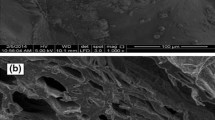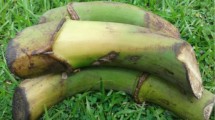Abstract
Color is one of the major remaining contaminants in the palm oil mill effluent (POME) following the conventional treatment of POME. The removal of color from POME using adsorption on activated carbon was investigated. The adsorption experimental design was performed using the standard response surface method (RSM) design that is central composite design to determine the optimum process variables for color removal by using the Design-Expert software (version 7.0. Stat-Ease, trial version). Besides obtaining optimum values, RSM also has the advantage of studying the interaction between various experimental parameters compared to one-factor-at-a-time. The equilibrium experimental data were analyzed by Langmuir and Freundlich isotherms. The statistical analysis showed that the quadratic model as well as the model terms was significant. The model had very low probability value (0.0003). The R 2 for the model was 0.9184 and the adjusted R 2 was 0.8380. The validation of the model showed experimental value and predicted value of 0.124 and 0.106, respectively. The optimum conditions suggested by the model for the process variable were 87.9 min, 4.05 and 7.86 g, for time, pH and granular activated carbon dose, respectively. The maximum removal obtained at these conditions was 89.95 %. The adsorption isotherm data were fitted well to the Langmuir isotherm compared to Freundlich isotherm with R 2 value of 0.850 for the former and 0.273 for the later.






Similar content being viewed by others
References
Acar FN, Eren Z (2006) Removal of Cu(II) ions by activated poplar sawdust (Samsun Clone) from aqueous solutions. J Hazard Mater B 137:909–914
Ahmad AL, Ismail S, Bhatia S (2003) Water recycling from palm oil mill effluent (POME) using membrane technology. Desalination 157:87–95
Alam MdZ, Muyibi SA, Mansor MF, Wahid R (2006) Removal of phenol by activated carbons prepared from palm oil mill effluent sludge. J Environ Sci 18(3):446–452
Ali I (2013) The quest for active carbon adsorbent substitutes, inexpensive adsorbents for toxic metal ions removal from wastewater. Sep Purif Rev 39:95–171
Ali I, Asim M, Khan TA (2012) Low cost adsorbents for the removal of organic pollutants from wastewater. J Environ Manag 113:170–183
Alkhatib MF, Muyibi SA, Amode JO (2011) Optimization of activated carbon production from empty fruit bunch fibers in one-step steam pyrolysis for cadmium removal from aqueous solution. Environmentalist 31:349–357
Baseri JR, Palanisamy PN, Sivakumar P (2012) Comparative studies of the adsorption of direct dye on activated carbon and conducting polymer composite. E-J Chem 9(3):1122–1134
Bello MM, Nourouzi MM, Chuah Abdullah L, Choong TSY, Koay YS, Keshani S (2013) POME is treated for removal of color from biologically treated POME in fixed bed column: applying wavelet neural network (WNN). J Hazard Mater 262(15):106–113
Borja R, Banks CJ (1994) Anaerobic digestion of palm oil mill effluent using up-flow anaerobic sludge blanket reactor. Biomass Bioenergy 6:381–389
Bousher A, Shen X, Edyvean RGJ (1997) Removal of coloured organic matter by adsorption onto low-cost waste materials. Water Res 31:2084–2092
Divya N, Bansal A, Jana AK (2013) Photocatalytic degradation of azo dye Orange II in aqueous solutions using copper-impregnated titania. Int J Environ Sci Technol. doi:10.1007/s13762-013-0238-8
Gupta VK, Mittal A, Krishman L, Mittal J (2006) Adsorption treatment and recovery of the hazardous dye, brilliant blue FCF, over bottom ash and de-oiled soya. J Colloid Interface Sci 293:16–26
Gupta VK, Jain R, Varshney S (2007) Removal of Reactofix golden 3 RFN from aqueous solution using wheat husk—an agricultural waste. J Hazard Mater 142:443–448
Gupta VK, Mittal A, Malviya A, Mittal J (2009) Adsorption of carmoisine A from wastewater using waste materials—bottom ash and deoiled soya. J Colloid Interface Sci 335:24–33
Gupta VK, Agarwal S, Saleh TA (2011) Chromium removal by combining the magnetic properties of iron oxide with adsorption properties of carbon nanotubes. Water Res 45:2207–2212
Karthikeyan S, Gupta VK, Boopathy R, Titus A, Sekaran G (2012) A new approach for the degradation of high concentration of aromatic amine by heterocatalytic Fenton oxidation: kinetic and spectroscopic studies. J Mol Liq 173:153–163
Leon y Leon CA, Solar JM, Calemma V, Radovic LR (1992) Evidence for the protonation of basal plane sites on carbon. Carbon 30:797–811
Lin SH, Lo CC (1996) Treatment of textile wastewater by foam flotation. Environ Technol 17:841–849
Lopez-Grimau V, Gutierrez MC (2006) Decolourisation of simulated reactive dyebath effluents by electrochemical oxidation assisted by UV light. Chemosphere 62:106–112
Mall ID, Srivastava VC, Agarwal NK, Mishra IM (2005) Removal of congo red from aqueous solution by bagasse fly ash and activated carbon: kinetic study and equilibrium isotherm analyses. Chemosphere 61:492–501
McClung SM, Lemley AT (1994) Electrochemical treatment and HPLC analysis of wastewater containing acid dyes. Text Chem Color 26:17–22
Mittal A, Gupta VK, Malviya A, Mittal J (2008) Process development for the batch removal and recovery of a hazardous, water-soluble azo dye (metanil yellow) by adsorption over waste materials (bottom ash and de-oiled soya). J Hazard Mater 151:821–832
Mittal A, Mittal J, Malviya A, Kaur D, Gupta VK (2010) Adsorption of hazardous dye crystal violet from wastewater by waste materials. J Colloid Interface Sci 343:463–473
Mohammed RR (2013) Decolorisation of biologically treated palm oil mill effluent (POME) using adsorption technique. Int Refer J Eng Sci 2(10):01–11
Namasivayam C, Dinesh KM, Selvi K, Ashruffunissa BR, Vanathi T, Yamuna RT (2001a) Waste coir pith—a potential biomass for the treatment of dyeing wastewaters. Biomass Bioenergy 21:477–483
Namasivayam C, Radhika R, Suba S (2001b) Uptake of dyes by a promising locally available agricultural solid waste: coir pith. Waste Manage 21:381–387
Ncibi MC, Mahjoub B, Seffen M (2007) Adsorptive removal of textile reactive dye using Posidonia oceanica (L.) fibrous biomass. Int J Environ Sci Technol 4(4):433–440
Oakes J, Gratton P (1998) Kinetic investigations of the oxidation of arylazonaphthol dyes in hypochlorite solutions as a function of pH. J Chem Soc Perkin Trans 2(10):2201–2206
Özer A, Gürbüz G, Calimli A, Körbahti BK (2009) Biosorption of copper (II) ions on Enteromorpha prolifera: application of response surface methodology (RSM). Chem Eng J 146:377–387
Pala A, Tokat E (2002) Colour removal from cotton textile industry wastewater in an activated sludge system with various additives. Water Res 36:2920–2925
Papic S, Koprivanac N, LoncaricBozic A (2000) Removal of reactive dyes from wastewater using Fe(III) coagulant. J Soc Dyers Colour 116:352–358
Poulios I, Aetopoulou I (1999) Photocatalytic degradation of the textile dye reactive orange 16 in the presence of TiO2 suspensions. Environ Technol 20:479–487
Sanghavi BJ, Srivastava AK (2010) Simultaneous voltammetric determination of acetaminophen, aspirin and caffeine using an in situ surfactant-modified multiwalled carbon nanotube paste electrode. Electrochim Acta 55:8038–8048
Sanghavi BJ, Mobin SM, Mathur P, Lahiri GK, Srivastava AK (2013) Biomimetic sensor for certain catecholamines employing copper(II) complex and silver nanoparticle modified glassy carbon paste electrode. Biosens Bioelectron 39:124–132
Toor M, Jin B (2012) Adsorption characteristics, isotherm, kinetics, and diffusion of modified natural bentonite for removing diazo dye. Chem Eng J 187(1):79–88
Velmurugan P, Rathina KV, Dhinakaran G (2011) Dye removal from aqueous solution using low cost adsorbent. Int J Environ Sci 1(7):1492–1503
Yusoff I (2006) Renewable energy from palm oil-innovation on effective utilization of waste. J Clean Prod 14:87–93
Zahrim AY, Rachel FM, Menaka S, Su SY, Melvin F, Chan ES (2009) Decolourisation of anaerobic palm oil mill effluent via activated sludge-granular activated carbon. World Appl Sci J 5:126–129
Acknowledgments
The authors duly acknowledge the contributions of the Department of Biotechnology Engineering, International Islamic University Malaysia, for providing all the basic laboratory facilities to accomplish the research work. The authors also wish to thank Mr. Mutiu Kolade Amosa for his valuable assistance in the editing of this manuscript.
Author information
Authors and Affiliations
Corresponding author
Rights and permissions
About this article
Cite this article
Alkhatib, M.F., Mamun, A.A. & Akbar, I. Application of response surface methodology (RSM) for optimization of color removal from POME by granular activated carbon. Int. J. Environ. Sci. Technol. 12, 1295–1302 (2015). https://doi.org/10.1007/s13762-014-0504-4
Received:
Revised:
Accepted:
Published:
Issue Date:
DOI: https://doi.org/10.1007/s13762-014-0504-4




